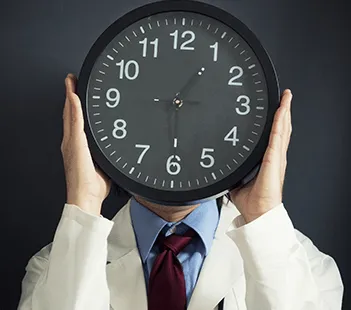March 27, 2018

By: Sansrita Nepal, M.D., Marisa Echaniz, M.D. and Joseph Walker Keach, M.D.
The Night Shift – it’s a crucial part of a resident physician’s training given hospitals’ 24-7 patient care delivery. It is also an opportunity to better educate our residents, develop camaraderie and improve patient care. Changes in resident physician work hours have prompted many internal medicine residency programs to adopt a night shift schedule. Residents commonly admit new patients overnight in order to hand them off to the oncoming day team as well as provide cross coverage to the patients that are already admitted. Trainees may spend up to four months total on night-shift rotations over the course of three years of training. While the regulations were implemented to benefit patient safety and improve resident satisfaction, they have also been reported to provide fewer learning opportunities. In 2012, a study by investigators at the University of California, San Francisco (UCSF) found that increased overnight supervision of residents by attendings enhanced clinical value of the night shift rotation, increased rates of attending contact during critical clinical decision-making and improved perception of patient care. These changes occurred without a decrease in residents’ perceived decision-making autonomy.
In light of the UCSF study, and feedback from our trainees, it became clear that increasing hospitalist attending and resident interaction would be beneficial to patient care and the resident experience. The challenge, however, was to design a nighttime curriculum which added the desired value, and still allowed both groups to provide excellent care for patients throughout the night. Red Eye Rounds (RER) was created from this concept – with a catchphrase that describes our mission – “Knowledge in the Cloak of Darkness”.
In order to develop the RER curriculum, we surveyed residents regarding the positive and negative aspects of their night shift experience. Using this input, the Red Eye Rounds task force created a curriculum to address the reported deficiencies in the night shift educational experience. This curriculum offers a structured and predictable way to troubleshoot complex medical and patient flow issues, as well as creates an opportunity to teach and discuss complicated patient cases.
Red Eye Rounds occur every night at midnight, and last for approximately fifteen minutes. They are led by a hospitalist attending, with all night shift residents, interns and medical students in attendance. We created an easy-to-use curriculum for our hospitalist attendings to teach from, consisting of a high yield system-based question bank, a collection of key practice changing articles, and a collection of the common cross cover issues encountered overnight. The hospitalist attendings can quickly access and utilize these resources at night without having to prepare to teach during an already busy shift. We then pilot tested RER, refining the process throughout. It was officially integrated into the hospitalist and resident workflow in August 2017. Seven months after the official launch, we find that meeting with the residents at midnight improves faculty awareness about patients approaching a need for a higher level of care, streamlines logistical decisions affecting triage, and overall increases night-shift satisfaction for both the attendings and residents.
Red Eye Rounds has received overwhelmingly positive feedback from the residents and the hospitalist group. A couple of our hospitalist colleagues had this to say:
“I’m finishing up nights tonight. The Red Eye Rounds is really a good thing. It’s changing the dynamic between us and the residents literally overnight! Almost every night they are calling us asking a question about management or something else. Such a good thing!”
“When we’ve called the residents every night regarding admissions, they seem interested and engaged…. There also seems to be more of a sense that they should feel free to call us anytime they have questions or concerns."
The chief resident at Denver Health responded:
“All of the residents have really enjoyed it. They have told me how much they enjoy having a face-to-face meeting with the hospitalist as it provides them an opportunity to ask clinical questions, and also gives them a chance to discuss admission flow. Out of all of the projects implemented this academic year at Denver Health it has been one of the most successful, and is being emulated at our other clinical sites.”
As with any new endeavor, we have encountered some obstacles. One hurdle has been to ensure that rounds consistently happen every night at midnight. Busy shifts with high patient volumes can impede the hospitalist attendings and the residents from stopping their work to participate in RER. To help better understand this process, we have started to track attendance at night in terms of rounds occurring, and how many hospitalists and residents attend. It takes time to change culture and embed a new program, but other things that we have done to help this issue are post flyers announcing the details of Red Eye Rounds, make announcements at both hospitalist division meetings and the resident noon conference. We’ve even handed out t-shirts with our logo to create excitement and generate interest!
We are currently exploring methods to solve these problems, including seeking funds to support our initiative with clinical question bank materials, and coffee and snacks during the rounds, as we feel that food would help motivate resident and attending participation.
Improving our nighttime curriculum has the potential to improve the quality of training for our residents, enhance hospitalist attending satisfaction with their teaching roles, and most importantly – provide better care to our hospitalized patients at night.

